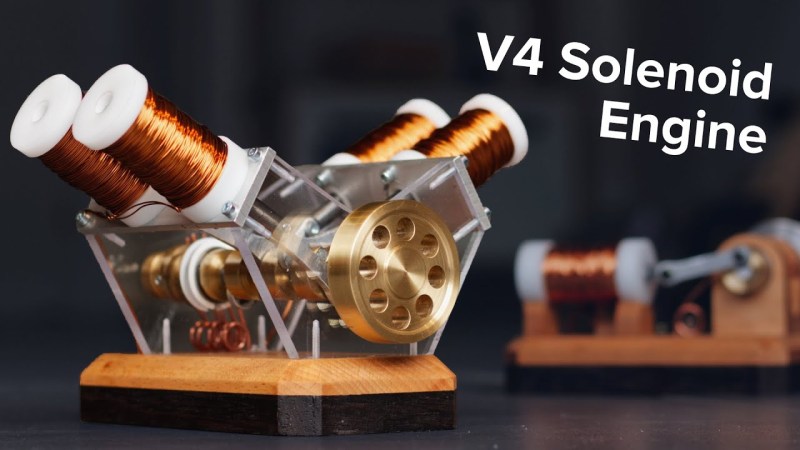The earliest piston engines typically had only one cylinder, and at best, produced horsepower measured in single digits. But once you have a working engine, it’s a relatively short step to adding cylinders and increasing the power output. [Emiel] made a similar upgrade to one of his engines recently, upgrading it from one cylinder to four. But this isn’t an internal combustion engine, it gets its power from electric solenoids.
We featured his single-cylinder build about a month ago, and since then he’s been busy with this impressive upgrade. The new engine features four cylinders arranged in a V4 pattern. Of course, this greatly increases the mechanical complexity. To start, he had to machine a crankshaft to connect all four “pistons” to a shared output shaft. He also had to build a set of cams in order to time the firing of the cylinders properly, so they don’t work against one another.
The build is just as polished and impressive as the last, which is saying a lot. [Emiel] has a quality machine shop and built the entire motor from scratch, including winding the solenoids, machining the connecting rods and shafts, and building a very picturesque wooden base for the entire contraption to sit on. It’s definitely worth checking out.
















More like engineering for kicks, than practical engineering, no problem we all need a diversion, and his shop is more practical than a full on bass boat for the weekend fisherperson. I did drown worms on occasion, but not often because a license is the most expensive part of the kit and only lasts a year. When I got old enough as to not need a license the State increased the age of eligibility.
That right there is called a tangent. ;)
Nice job on the motor, I always loved making home made electric motors. Sometimes from just paperclips and wire, other times random screws or nails and wire. I made this for my son some years back: https://www.youtube.com/watch?v=JJDsEZVhFzQ
Chris, Your motor looks nice, no link to build notes though.
Props to the Emeil for the nice build.
Sound like a diesel loll nice build
It is not a 4 stroke! Why does he keep saying that?
I’m not an engine specialist at all, but it looks like a 2 stroke V2x2 to me. I call it a V2x2 and not a V4, because I think (don’t hold me to it please) that in a V4 the cylinders should be out of phase, while this device seems to have them in phase.
I think they are out of phase, because there is four cams?
By “out of phase” and “in phase” i think you mean what is called called flat-plane crank and cross-plane crank, from how it looks from one end (A “plus” or a line/flat). Almos all inline-4 engines are flat-plane(2 cylinders go up and down together), but cross-plane do indeed exist, i.e. the Yamaha R1 motorcycle, which has a cross-plane, which makes is sound more like a V4, because of the uneven firing order. This has 4 cam-lobes, so each cylinder is firing individually. Older magnet-based ignition-systems are running “wasted spark”, which means the spark plug fires each revolution, but that is only possible since it’s a 4-stroke. 2-strokes needs to fire every revolution, because of the nature of the engine.
This seems to be a 2-stroke (Every other stroke is a power-stroke) cross-plane engine(No 2 pistons are moving together. This can be easily seem on the cam-lobes, since every piston have their own offset)
OK, that’s a beautiful build, but more importantly, can I have this guy come over and set up a shop in my basement? I always thought I didn’t have enough room, but he’s packed so much functionality into that tiny space. I need it.